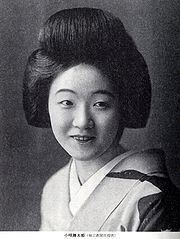Birth name Katsu Shinno Role Singer Name Katsutaro Kouta | Years active 1930–1974 Occupation(s) Singer Died June 21, 1974 | |
 | ||
Born November 6, 1904Nigata prefecture, Japan ( 1904-11-06 ) Genres Ryukoka,Min'yo,Hauta,Kouta,Kiyomoto Similar People | ||
Vintage japanese music sangai bushi sado okesa by katsutaro kouta 1938
Katsutaro Kouta (小唄 勝太郎, Kouta Katsutarō, November 6, 1904 – June 21, 1974) was a Japanese female geisha and ryūkōka singer. The genre like her songs was called "New-Minyo". The era when she had a high popularity with another popular geisha singer Ichimaru was called the "Katsu-Ichi Era". Note "Shinno" was her family name after married, her real name was "Sato".
Contents
- Vintage japanese music sangai bushi sado okesa by katsutaro kouta 1938
- Teichiku 796 c1681 78rpm houta par katsutaro kouta
- Career
- Kohaku Uta Gassen Performances
- Discography
- References
Teichiku 796 c1681 78rpm houta par katsutaro kouta
Career
Katsutaro was born on 6 November 1904 at Niigata Nuttari-cho, Nakakanbara District,Niigata Prefecture. At her child ages, she worked as a helper at her relative's restaurant, and she became a geisha at 15 years old. She had a fondness with kiyomoto, so around late Taisho period she moved to Tokyo, accepted in Yoshicho geisha district and admitted as Katsutarō. Around 1928 a geisha from the same hanamachi, named Fumikichi(二三吉) had several hits in Victor of Japan. In 1930 Katsutaro recorded some hauta and kouta song with Odeon Record and Parlophone. A year later she signed exclusive contract with Victor. She debuted with the song "Sado Okesa" (佐渡おけさ) in 1931. In 1932, her B-side song titled "Yanagi no Ame"(Willow Rain) became her first hit. She released song "Shima no Musume" (島の娘, lit. Island Girl) in 1932. The song became a big hit in 1933, selling 350.000 copies in 3 months, with total 600,000 copies. However, the song also angered members of the Home Ministry because the song described illicit sexual relations.
In 1933, Katsutaro and Issei Mishima released duet song "Tokyo Ondo" in June or July when Bon Festival in 1933. The song composed by Shinpei Nakayama. It sold 1.2 million copies and became the highest selling single in Japan at that time. Also in 1933, she leave the geisha world to concentrating on her new profession as a recording artist and dropped the Yoshicho name, became just "Katsutarō", and released other hit, Oshima Okesa
Then in 1934 spring season, she, Mishima Issei and Tamaki Tokuyama release the song Sakura Ondo and also became a big hit. On the same year, she received name "Kouta Katsutarō" in an open exhibition. After the name change, she released more song and even became bigger star. Even songwriter Nagata Mikihiko(長田幹彦)dubbed she and Ichimaru as "Emotional Katsutarō and Intelectual Ichimaru". And around mid 1930s is called the "Katsu-Ichi Jidai" (勝市時代, Katsu Ichi Era). In late 1930s she and other singers called to China to performing for Japanese troops in China. And when she sick there, she met military physician Shinno Ryouichi, the two became a couple and married in 1949. In wartime, she recorded the song Asu wa Otachika and became a hit.
After war ended she transferred to Columbia and in 1948 to Teichiku, and her song Oshima Jowa became a hit and used for a movie with the same name. In 1950 she with Hamako Watanabe invited to America for perform, with addition to Brazil with Taro Shoji where she get a warm welcome from Japan citizens there.
In 1961 she transferred to Toshiba Record where she recording most hauta and kouta song. Around mid 1960s she back to Victor to re-record her hits in Victor. By mid 1960s, oldies were boom, many old singers record the stereo version of their hits and a tv program called Natsukashi no Utagoe (Nostalgic Songs) was started in 1968. Katsutaro appeared regularly until just before her death. In 1971 she get award Purple Ribbon and an award again in 1974. In June 1974 she diagnosed from lung cancer and die on June 21, 1974 on Fuchu Hospital at Tokyo, aged 69 and marked the end of her long 43 years career as a singer. On September 25, 2005, a monument to Kouta was established in her birthplace, Niigata.
Kohaku Uta Gassen Performances
According to Japanese Wikipedia, she took part three times in Kohaku Uta Gassen
-4th Kohaku Uta Gassen (located at Nihon Gekijo) Song performed : Shima no Musume
-6th Kohaku Uta Gassen (located at Sankei Hall) Song performed : Osome
-7th Kohaku Uta Gassen (located at Tokyo Takarazuka Theater) Song performed :Tojin Okichi no Uta
Discography
Oshima Jowa(大島情話) : 1948
